Wednesday, August 30, 2017
Aberreel to reel
Article at RealClear credits one NYC bookstore for maintaining and spreading 'alternative' religions. Says that without this one bookstore, most of the country would have no occult coverage at all.
 And a note from semi-direct experience: Grandma was always into occult stuff. When she lived in Ponca in the '20s, she was getting regular 'readings' from a medium named Mrs Early. So the mediums were there whether NYC heard about them or not.
And a note from semi-direct experience: Grandma was always into occult stuff. When she lived in Ponca in the '20s, she was getting regular 'readings' from a medium named Mrs Early. So the mediums were there whether NYC heard about them or not.
Outside of the eastern cities, though, there were only ever small pockets of professional occultists. Indiana, for example, had eight mediums in the small Northern towns of Elkhart, Mishawaka, South Bend, and LaPorte, plus a “spirit room” run by a former U.S. Congressman. In other places, though, occult belief was nearly impossible to find. The whole state of Minnesota had only one professional medium. Kentucky also had only one. There were none in the new state of Kansas.Well, it wasn't like that. Looking through the Aberree, especially the ads in the last few pages of each issue, gives a different picture. All sorts of occult publishers and speakers and 'mediums' were actively competing for the market. Alphia Hart began as an alternative Hubbardist but got most of his ads and most of his contributed articles from old-fashioned occultists. His editorials took a cautious attitude toward the mix, separating harmful and helpful practitioners. He praised writers and mediums who were trying to help people survive, and bashed those who were trying to exert power over clients. Why was the RCL writer unable to find much documentation of spiritualism in the Midwest? Partly from the universal bias of librarians. Fashionable views get into libraries, unfashionable views are memoryholed. But there's a second factor related to mediums. Hart reported on all sorts of activities: conferences, books, competing magazines, and TAPES. In 1954 when tape machines were rare, reel-to-reel audiotape was already the DOMINANT medium for mediums. Even if libraries didn't automatically reject the material, tapes would be unreferenceable.
 And a note from semi-direct experience: Grandma was always into occult stuff. When she lived in Ponca in the '20s, she was getting regular 'readings' from a medium named Mrs Early. So the mediums were there whether NYC heard about them or not.
And a note from semi-direct experience: Grandma was always into occult stuff. When she lived in Ponca in the '20s, she was getting regular 'readings' from a medium named Mrs Early. So the mediums were there whether NYC heard about them or not.Labels: Aberree
